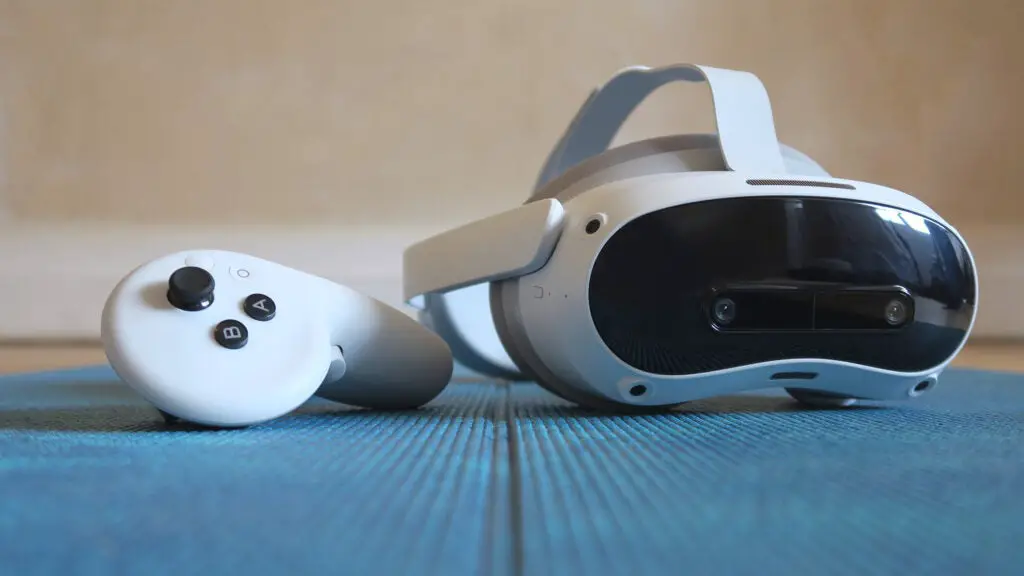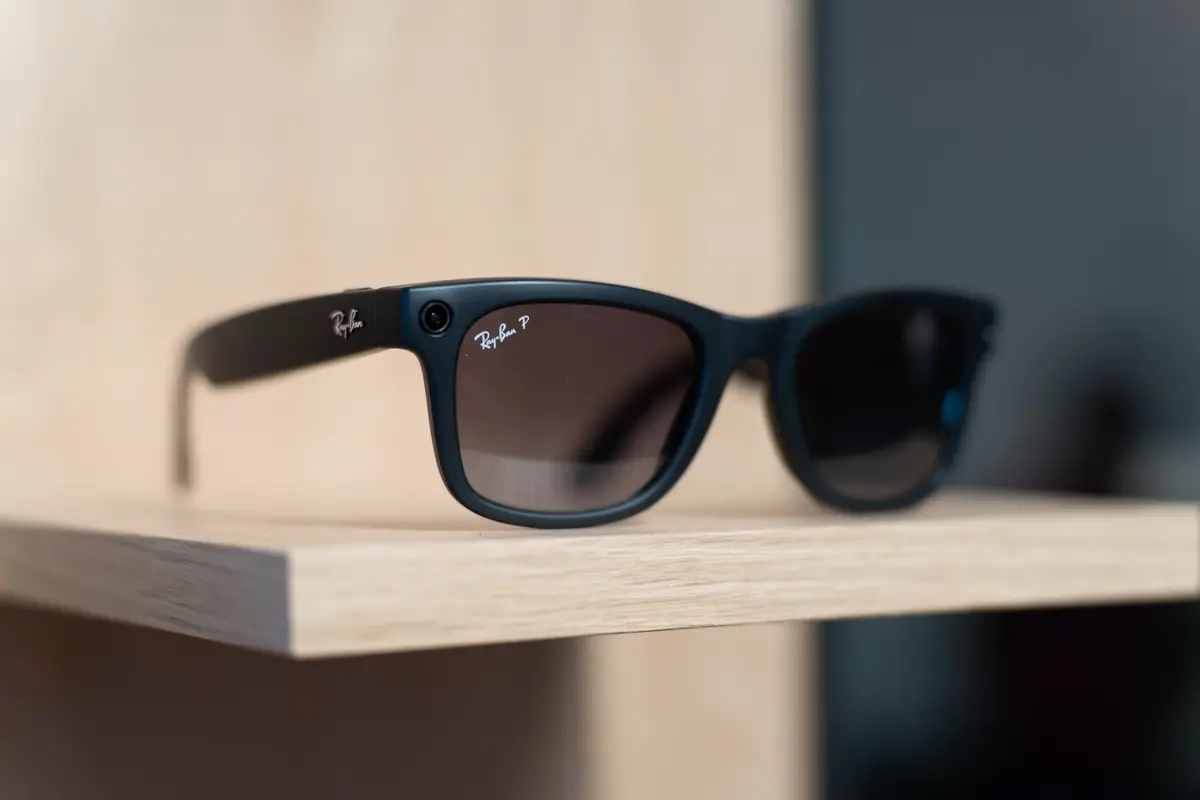Verdict
The Pico 4 Ultra is a superb headset with outstanding tracking, great functionality across virtual and mixed reality, and future-proofed hardware. However, even though Pico has made huge strides in levelling the playing field in terms of hardware, Meta still has the edge when it comes to offering high-profile and exclusive games and experiences in its store.
Pros
- Comfortable, balanced design
- Class-leading performance
- Easy setup full-body tracking
Cons
- Lack of software exclusives
- Highly varied content quality
- Motion trackers sold separately
Key Features
- Mixed realityBlends both the virtual and real-world space to add more variety for apps and game experiences.
- Peak memoryThe Pico 4 Ultra matches the Quest 3’s top-tier chipset, but trumps Meta’s headset by offering 12GB of RAM (instead of 8GB).
- Ringless controlsLike the Meta Quest 3’s Touch plus controllers, the Ultra ditches the rings of its predecessor’s, for a cleaner ringless design.
Introduction
Pico has had a rough time lately. Despite being practically the only noteworthy competitor to Meta’s monopoly in the VR space, its last headset – the Pico 4 – didn’t appear to meet parent company Bytedance’s expectations.
Fans claim lacklustre sales figures and a lack of US availability were the driving force behind the cancellation of the Pico 5; the company’s next expected headset that, based on leaks, was going to be a true powerhouse in the mid-range market.
Even with a fully-fledged successor on ice, however, Pico isn’t prepared to take the Meta Quest 3‘s subsequent technical superiority lying down, and in response, we now have a follow-up to 2022’s Pico 4 in 2024’s Pico 4 Ultra.
As the name suggests, the Ultra builds on everything that made the Pico 4 what it was; from its familiar design to a near-identical optical stack. However, the Ultra elevates the rest of the standard model’s virtual (and mixed) reality chops in every way.
At the heart of it, the Pico 4 Ultra upgrades to the same Snapdragon XR2 Gen 2 chip you’ll find inside Meta’s Quest 3, which means way more power than the standard Pico 4, paired with a class-leading amount of RAM, to provide a little future-proofing. Revised controllers also look decidedly Quest 3-like, having ditched the old wraparound tracking rings for something much more compact.
Beefy new 32MP dual front cameras help with improved pass-through, promise significant gains with mixed reality experiences and even offer spatial still and video capture.
As a result, the Pico 4 Ultra lords over the standard model (and in many areas, the Meta Quest 3) at a hardware level, but a rich content library (with perhaps a few exclusive titles thrown in) is what really makes or breaks any modern VR system.
So, does the Ultra take Pico from playing catch-up to being caught up?
Design and fit
- Comfortable counterbalanced design like Pico 4
- No physical audio ports
- Included fabric facial interface isn’t great for hygiene
The Ultra adopts a very similar design to the original Pico 4, with a shiny black visor on the front (prone to fingerprints and smudges), set against a matte grey plastic body, with a flexible over-the-head hook-and-loop strap for added support.
The battery pack is again set into the back of the head strap, which paired with the near-perfect weight distribution (304 grams in the front and 276 grams at the back) means extended play sessions are wholly approachable.
Adjusting the headset is painless too, with the strap hinging down over the back of your head and a double rack-and-pinion (similar to the admittedly less stable PlayStation VR 2), allowing for easy tightening and release, with the twist of the dial.
Once on, the cushioning around the lenses is decent, however, the sweet spot for central clarity and definition meant I usually had to tighten the headset with the fabric resting atop my cheekbones (as opposed to a little further down my cheeks, which would have made the wear experience less noticeable).
The magnetically detachable fabric facial interface is comfortable, and Pico even throws in a spacer for prescription lenses, but a PU alternative (like the one included with the business-centric Pico 4 Ultra Enterprise Edition) wouldn’t have hurt; especially from a hygiene perspective, for those considering a headset as a fitness aid or when taking turns with friends.
Speakers are set into the arms of the pre-fitted strap and offer respectably clear and loud sound, with pleasant depth, especially considering their size. This is just as well, though, as Pico still refuses to include a physical headphone/microphone port, so Bluetooth audio is your only other option (thankfully pairing is just the same as when connecting to a smartphone).
The innocuous chromed vents above and below the visor actually play host to a fan-driven cooling system that, while great at stopping the lenses from fogging, also dries out your eyes after a while.
Controllers
- Tracking ring-less design
- Haptics could be better
- Motion trackers are unobtrusive
As for the controllers, they’ve gone the way of the Meta Quest 3 with a decidedly Touch Plus-like ringless design, and that means they’re lighter and less obtrusive than the Pico 4’s were.
I would argue that despite their bombastic name, the ‘HyperSense broadband linear motors’ at play are a little insipid, especially when they spin up in an attempt to reflect high action within whatever experience you’re enjoying. I’m crossing my fingers for greater precision and range with future releases, though.
It’s otherwise a familiar layout: trigger and grip buttons around each handle, plus a thumbstick, A, B (on the right controller), X and Y (on the left) buttons and two additional smaller buttons; one on each that lets you hide all UI elements or jump back to the main home interface and a screenshot button on the right controller, in contrast to a menu button on the left.
If you pre-ordered the 4 Ultra (or you’re willing to fork out an additional £80), you’ll also have Pico’s new motion trackers to play with. These small grey plastic pucks neatly attach to sprung, hinged USB-C mounts that you attach to each ankle, using the integrated stretchy hook-and-loop straps.
Once attached, they stay in position without too much tension and at 38.5 grams each (you get two in a box), are comfortable and unobtrusive enough to leave on throughout a play session, even if you aren’t always playing compatible games.
Specs and features
- Powered by Qualcomm Snapdragon XR 2 Gen 2
- 12GB RAM / 256GB of storage
- Dual 32MP RGB stereoscopic pass-through w/ spatial capture support
Although the Ultra resembles the standard Pico 4 at a glance, one of the first differences you’ll likely notice is the new camera hardware, set into its black visor.
While the original had a single 16MP RGB camera, the Ultra swings for a pair of higher fidelity 32MP RGB snappers (accompanying the quartet of environment-tracking IR cameras). Marry that with an iToF depth-sensing camera (for half-decent hand-tracking), and the pass-through and mixed reality fidelity can be considered best-in-class.
For comparison’s sake, the Meta Quest 3 uses a pair of comparatively lowly 4MP RGB cameras for its stereoscopic pass-through. Even with the resolution bump though, it is worth noting that both systems suffer from the same issue of limited dynamic range; meaning pass-through clarity (and to a lesser extent tracking reliability) can be impacted when using either headset in dimmer (or overtly bright) conditions.
Even with the additional pixels, the 4 Ultra’s pass-through clarity wasn’t as good as I’d hoped either, with the keys on my laptop’s backlit keyboard and text on my smartphone screen both proving difficult to readily discern.
Going from 2D to 3D pass-through is a huge upgrade in its own right, making living with the Pico 4 Ultra – and navigating your surroundings without having to remove it – that much easier, but the jump to stereoscopic vision also brings one other bonus: spatial capture.
Not only can you capture spatial stills and videos using the Ultra, provided you’re signed in on the same account on the Pico app for iOS, but you also gain the option to transfer spatial videos shot on compatible iPhones or with Apple Vision Pro and view it on the Ultra, using the headset’s native Photos app (these are of a much higher quality than what the headset itself can capture too). All that said, spatial capture on the Pico 4 Ultra is a head-turning novelty, rather than a reason to buy.
The combination of IR markers and Pico’s proprietary ‘Centaur multi-modal algorithm’ make for one heck of a duo, when it comes to tracking on the Ultra. The 6 DoF system proves very reliable when placing elements in 3D space when using mixed reality and controller positioning, too, is almost unflappable.
In contrast, hand tracking takes a little more getting used to and I found I had to angle my hands inward so that the headset could more clearly ‘see’ what gesture I was trying to perform, sometimes.
The additional motion trackers are easy to setup and calibration comes down to just looking down at your feet, but they had a harder time mirroring my leg movements 1:1. It’s also telling that in all of Pico’s marketing material, those sporting the trackers are in shorts, as you need to ensure there’s no fabric (such as rucking trouser legs) blocking line of sight with the headset for optimal performance.
As such, while they’re convenient for out-of-the-box use with experiences like VRChat and Tempo Club, I don’t know if they add all that much.
The viewing experience comes courtesy of a near-identical optical stack to the standard Pico 4, which means it does lag behind the Meta Quest 3 in aspects like peak refresh rate (90Hz compared to up to 120Hz on the Quest). Thankfully, you still get powered IPD adjustment (58-72mm), a respectable 105-degree FoV – even if that means there’s still an obvious framing to content – while a resolution of 2160 x 2160 per eye ensures crisp visuals too.
I just wish more games employed better anti-aliasing, as jagged lines aren’t uncommon on the boundaries of elements in some (but not all) titles.
While the panel used is still an LCD, Pico has reportedly increased brightness by 25% compared to the Pico 4, and although I wasn’t able to make a side-by-side comparison, visual quality – in terms of both colour and contrast – seriously impressed for the tech, especially considering these are microLED and I’ve tested microOLED-toting headsets (like the Apple Vision Pro) that don’t deliver an earth-shatteringly superior viewing experience, despite the obvious price disparity.
Beyond the screens, the most significant and necessary upgrade that the Pico 4 Ultra serves up is its use of Qualcomm’s Snapdragon XR2 Gen 2 chipset. It’s the same silicon that gave the Quest 3 such a performance advantage over the base Pico 4 and reportedly delivers a 250% bump in GPU performance over the XR2 Gen 1, used by Pico’s previous headset.
That also comes paired with a whopping 12GB of RAM on the Ultra (the Quest 3 has 8GB), which – considering the Quest seldom felt taxed – I can only assume is in the pursuit of future-proofing on Pico’s part, as the Ultra also took every game in its stride. It’s also impressively rapid at waking from sleep, so you can pop it on your head and be up and running in seconds.
While the Quest 3 comes in 128GB and 512GB flavours, the Pico 4 Ultra splits the difference on the storage front, with 256GB of (non-expandable) space. I had about 30 experiences loaded onto my review device, about half of which were sizeable games, like Arizona Sunshine 2 and Red Matter 2, and I’d only filled about a third of the Ultra’s memory.
App management is easy enough, although more in-depth insight into how much storage each app occupies and what permissions they’re using, would be appreciated added insight.
Games and software
- Greatly expanded catalogue since Pico 4 launched
- A real mix of quality in available content
- Lagging behind Meta in high-profile exclusives
One of the big caveats that came with recommending the previous Pico 4 was its catalogue, which paled in comparison to main rival Meta’s. In the intervening years, it’s clear the company has worked hard to expand its roster of apps, experiences and games, resulting in a reported 650 VR apps and 40 MR apps on Pico Store in 2024.
Big titles, like the aforementioned (and stunning) Red Matter 2, Demeo, Blade & Sorcery: Nomad, Job Simulator, Eleven Table Tennis and Angry Birds are all ready and waiting for Pico users to enjoy, but a quick glance at the Meta Horizon store reveals there are still big holes in its repertoire, especially where popular IPs like Assassin’s Creed, Beat Saber, Super Hot and Roblox are concerned.
To rub salt in the wound, even despite its efforts, titles like the forthcoming Just Dance VR – which was originally slated as a Pico exclusive – is now coming to the Meta Quest instead. It’s perhaps a symptom of Meta’s dominance in the space, that it can simply entice developers over with its larger audience, or outright buy up studios and produce big titles in-house in a way that Pico can’t, which means Pico’s content offering will always fall short.
With the brand’s origins as a Chinese-based company (nowadays owned by Bytedance), there’s a stranger side to the content on offer from the Pico Store and the Pico Video apps that might not resonate with international audiences quite so well.
Among interesting 360-degree wildlife videos and rollercoaster ride-alongs, it takes moments to get served ‘Premium’ videos like ‘Beautiful Russian Girls’. While the content in question isn’t exactly sordid, it doesn’t really align with the quality and timbre of the rest of what’s available to users, and at the very least should be gated behind age restrictions (Pico says its products and services are suitable for ages 13 and up).
I have no qualms with more adult-focused content on VR as a platform, but I think access to it needs to be intentional; users shouldn’t be able to happen upon it within Pico’s own first-party apps, without some forewarning, as I did.
Beyond content consumption, you can both share your viewpoint with friends by casting to the Pico app, a TV or web browser (which works well even wirelessly, thanks to the headsets’ latest WiFi 7 support), but Pico Connect is the bigger deal here.
Once you have the client installed and you’re logged in on the same account, you can view your computer within mixed reality and control it with your hands, controllers or your mouse and keyboard (native mouse and keyboard support via the headset is coming in a future OTA update).
As well as making your PC navigable on a resizeable floating window, you can also jump straight into Steam VR, greatly expanding Pico’s access to high-quality VR gaming. Wired connectivity is also on the table here for even lower latency, but die-hards will lament that this connection runs over USB 3.0 and not the superior DisplayPort standard.
Battery life
- Slightly larger 5700mAh battery
- Four hours of use on a single charge
- 45W charging delivers full charge in an hour
To accompany the additional cameras and performance served up here, the Pico 4 Ultra boasts a slightly larger battery than its 2022 predecessor, with a 5,700mAh cell (versus 5,300mAh) that at its best delivered around four hours of use on a charge, pipping the Quest 3 to the post by an extra hour.
Naturally, graphically demanding gaming will more readily tax things, compared to looking at photos or streaming video, with intense play eating up charge in about half that time.
While users will always clamour for longer battery life, the hard limit imposed here does align well with when I’d consider a healthy time to take a break. In a headset as immersive as this, I found it all too easy to lose hours to games like Red Matter 2. There is also a power saving mode, which lowers image quality, but I preferred running the Ultra down faster, at its highest fidelity.
As well as a larger battery, the Ultra benefits from markedly faster charging too (20W on the Pico 4 to 45W here). You’ll need to buy a Quick Charge compatible charger separately, at which point my tests delivered a 71% charger in 30 minutes and a full charge in a silver over an hour. That’s more than twice as fast as the Meta Quest 3 takes to charge (around 2.5 hours) with its 30W charging speeds.
As for the controllers, while Pico’s software doesn’t give you a percentage, after two weeks of use, they’re still showing ‘green’, which I’m taking to mean between 66% and 100% charge. This is made all the more impressive by the fact that each controller is powered by a pair of humble AA batteries that slot into the sprung magazine within their handles.
Latest deals
Should you buy it?
You want the best hardware in mid-range VR right now
The Pico 4 Ultra does what it set out to do: out-perform its main rival, the Meta Quest 3 on the hard
You want the best quality and exclusive gaming/software experiences
Pico has made strides in improving its software and gaming catalogue but it remains second fiddle to Meta’s.
Final Thoughts
All in all, the Pico 4 Ultra is an incredibly well-rounded VR headset, with everything you could want at this level, from future-proofed performance, decent battery life with great fast charging, exceptional positional and controller tracking, good optics and enough storage to enjoy all the content you’ll likely want to sink your teeth into.
It’s content that remains the thorn in Pico’s side. While the catalogue available to the Pico 4 Ultra is a marked improvement on what you could get when its predecessor launched, there are just some established brands, IPs and titles that Meta retains control over.
The Pico 4 Ultra covers everything you’d want at this price point, I just hope it sees enough success to push Pico to add more premium features into its successor. Perhaps a move to an OLED panel, eye tracking and foveated rendering; all wrapped up in an even lower-profile design.
How we test
We test every VR headset we review thoroughly. We use industry-standard tests to compare features properly and we use the phone as our main device over the review period. We’ll always tell you what we find and we never, ever, accept money to review a product.
Find out more about how we test in our ethics policy.
Tested a variety of AR and VR titles
Used games and apps to benchmark performance
FAQs
Does the Pico 4 Ultra have face tracking?
No.
Does the Pico 4 Ultra have hand tracking?
Yes. You can switch seamlessly from using the controllers to using your hands.
Does the Pico 4 Ultra support full-body tracking?
Yes, provided you buy a pair of Pico’s compatible motion trackers.
Full specs
UK RRP
USA RRP
EU RRP
Storage Capacity
Battery
Size (Dimensions)
Weight
ASIN
Release Date
First Reviewed Date
Resolution per eye
Refresh Rate
Processor
Headset tracking
Field of view
RAM
Sensors
Audio
Screen Technology
IPD
Pico 4 Ultra
£529
Unavailable
€599
256GB
5700 mAh
165 x 256 x 84 MM
580 G
B0D9WKDZXW
2024
30/09/2024
2160 x 2159
90 Hz
Qualcomm Snapdragon XR2 Gen 2
Yes
105 °
12GB
2x 32MP colour passthrough cameras, 1x iToF depth-sensing camera, 4x environment tracking cameras
Yes
IPS
72 mm











